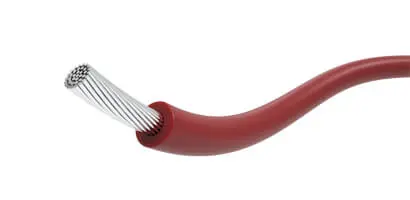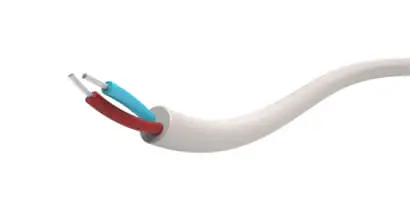Thermoplastics insulated wires are electrical conductors coated with materials like PVC, offering flexibility and heat resistance. Widely used in construction, automotive, and electronics, they provide efficient and durable solutions for electrical connections.

Operating Temperature: -30°C to +105°C
Operating Voltage: 600V
Insulation: extruded PVC
Approval: UL758

Operating Temperature: -20°C to +80°C
Operating Voltage: 300V
Insulation: extruded PVC
Approval: UL758

Operating Temperature: -30°C to +105°C
Operating Voltage: 600V
Insulation: extruded PVC
Approval: UL758

Operating Temperature: -30°C to +90°C
Operating Voltage: 1000V or 1200V
Insulation: extruded PVC
Approval: UL758

Operating Temperature: -30°C to +105°C
Operating Voltage: 300V
Insulation: extruded PVC
Approval: UL758

Operating Temperature: -30°C to +105°C
Operating Voltage: 600V
Insulation: extruded PVC
Approval: UL758

Operating Temperature: -30°C to +80°C
Operating Voltage: 300V
Insulation: extruded PVC
Approval: UL758

Operating Temperature: -30°C to +105°C
Operating Voltage: 300V
Insulation: extruded PVC
Approval: UL758

Operating Temperature: -30°C to +80°C
Operating Voltage: 30V
Insulation: extruded PVC
Approval: UL758

Operating Temperature: -30°C to +60 °C /80 °C
Operating Voltage: 30V
Insulation: extruded PVC
Approval: UL758

Operating Temperature: -30°C to +80°C
Operating Voltage: 300V
Insulation: extruded PVC
Approval: UL758

Operating Temperature: -30°C to +105°C
Operating Voltage: 300V
Insulation: extruded PVC
Approval: UL758

Operating Temperature: -30°C to +80°C
Operating Voltage: 300V
Insulation: extruded PVC
Approval: UL758

Operating Temperature: -30°C to +80°C
Operating Voltage: 300V
Insulation: extruded PVC
Approval: UL758

Operating Temperature: -30°C to +105°C
Operating Voltage: 300V
Insulation: extruded PVC
Approval: UL758

Operating Temperature: -30°C to +105°C
Operating Voltage: 300V
Insulation: extruded PVC
Approval: UL758
PVC Insulated Wires (Polyvinyl Chloride):
Widely used for general-purpose electrical wiring in residential, commercial, and industrial buildings.
PE Insulated Wires (Polyethylene):
Suitable for outdoor and underground applications due to its excellent moisture resistance.
XLPE Insulated Wires (Cross-Linked Polyethylene):
Offers superior thermal and mechanical properties, used in power distribution and industrial applications.
TPE Insulated Wires (Thermoplastic Elastomers):
Combines flexibility and durability, suitable for automotive wiring harnesses and portable appliances.
1. Raw Material Extraction:
Resource Depletion: Thermoplastics are typically derived from petroleum-based feedstocks or natural gas. The extraction of these fossil fuels contributes to resource depletion and environmental degradation.
Energy Consumption: The production of thermoplastic resins requires significant energy input, contributing to greenhouse gas emissions and overall energy consumption.
2. Manufacturing Process:
Emissions: The manufacturing of thermoplastic insulated wires involves various processes such as extrusion, molding, and coating, which may generate air emissions, wastewater, and solid waste.
Chemical Use: Chemical additives, stabilizers, and colorants are often incorporated into thermoplastic formulations, posing potential risks to human health and the environment if not properly managed.
3. Product Use:
Energy Efficiency: Thermoplastic insulated wires contribute to energy efficiency when used in electrical systems by reducing heat loss and improving insulation performance.
Longevity and Maintenance: Durable thermoplastic insulation can contribute to longer product lifespans and reduced maintenance needs, minimizing the overall environmental impact of replacement.
4. End-of-Life Considerations:
Recyclability: Some thermoplastic materials used in insulation, such as PVC (Polyvinyl Chloride), are recyclable. However, challenges exist in recycling mixed materials or contaminated plastics.
Waste Management: Improper disposal of thermoplastic insulated wires can lead to landfilling or incineration, contributing to waste generation and potential release of harmful substances.
5. Sustainable Practices and Mitigation Strategies:
Material Selection: Choose thermoplastic materials with lower environmental impacts, such as bio-based or recycled content plastics.
Recycling Programs: Support and participate in recycling programs that accept thermoplastic materials, promoting a circular economy.
Product Design: Optimize product design to reduce material waste, energy consumption, and emissions during manufacturing.
Lifecycle Assessment: Conduct lifecycle assessments (LCAs) to quantify and minimize environmental impacts across the entire product lifecycle, from raw material extraction to disposal.
6. Regulatory Compliance and Standards:
Compliance: Ensure compliance with environmental regulations and industry standards governing the production, use, and disposal of thermoplastic materials.
Certifications: Look for certifications such as RoHS (Restriction of Hazardous Substances) compliance to minimize the use of hazardous substances in thermoplastic insulation.